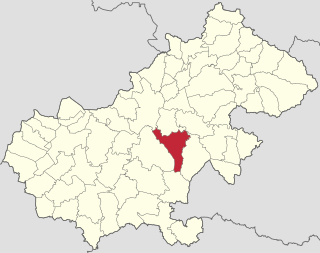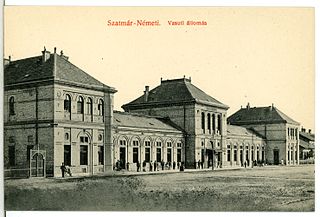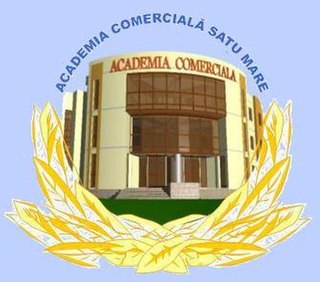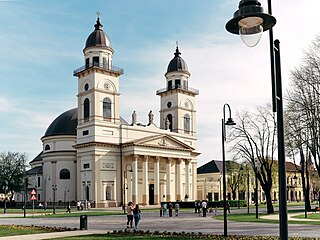Related Research Articles

Satu Mare is a city with a population of 102,400 (2011). It is the capital of Satu Mare County, Romania, as well as the centre of the Satu Mare metropolitan area. It lies in the region of Maramureș, broadly part of Transylvania. Mentioned in the Gesta Hungarorum as castrum Zotmar, the city has a history going back to the Middle Ages. Today, it is an academic, cultural, industrial, and business centre in the Nord-Vest development region.

Viile Satu Mare is a commune of 3,950 inhabitants situated in Satu Mare County, Romania. It is composed of five villages: Cionchești (Csonkaitanya), Medișa (Meddes), Tătărești (Résztelek), Tireac (Tirákpuszta), and Viile Satu Mare.

The Diocese of Satu Mare is a Latin diocese of the Catholic Church in Romania. It was established on 23 March 1804 by Francis I, King of Hungary, an act recognised by Pope Pius VII that 9 August. At the time, the diocese was part of the Kingdom of Hungary and covered a larger territory, including land in present-day Hungary and Slovakia as well as Romania. It was constituted in its present form on 18 October 1982, when the Communist regime split it from the Oradea Mare Diocese.

The Chains Church, a Reformed church in Satu Mare, Romania, is one of the oldest churches in the city.

The Calvaria Church is a Roman Catholic religious building in Satu Mare, Romania, and one of the oldest churches in the city. Located on Mihai Eminescu Street, it was originally built in 1844, and stands in place of the old fortress Castrum-Zothmar. Its original walls broke after the foundation caved over the sandy ground. The church was rebuilt from the ground up by the Weszelovszky brothers, in 1908–1909. The church has a height of 42 metres (138 ft).

Satu Mare railway station is the main station in Satu Mare, Romania. It is located near the city center. The station was first constructed in 1870; the current building dates from 1899 and was designed by the architect Ferenc Pfaff.

The SS. Michael and Gabriel Cathedral is a Greek-Catholic religious building in Satu Mare, Romania, built between 1932 and 1937 in place of an older church which had been opened in 1803. The newer edifice was commissioned to architects Victor Smigelschi and Gheorghe P. Liteanu, and its style relates to the Neo-Brâncovenesc architecture of the period, featuring a pendentive dome with towers on either side of the narthex and a monumental portal at the entrance.
Carpaţi II is a residential district of Satu Mare in Romania. It is named after the Carpathian Mountains.
Centru Nou is a residential district of Satu Mare in Romania. It was built in the late 1970s and includes the Administrative Palace, one of the tallest buildings in Romania.
Cloşca is a residential district of Satu Mare in Romania. It is named after the Romanian revolutionary Cloşca also known as Ion Oargă.
Crişan is a residential district of Satu Mare in Romania. It is named after the Romanian revolutionary Crişan also known as Marcu Giurgiu.

Horea is a residential district of Satu Mare in Romania. It is named after the Romanian revolutionary Horea also known as Vasile Ursu Nicola.
Gelu is a village of Satu Mare in Romania. It is named after the Romanian duke Gelou.
Menumorut is a residential district of Satu Mare in Romania.
Sătmărel is a residential district of Satu Mare in Romania. Legally a village administered by the city, it was a separate commune until the 1980s. It has a population of 1,136 Inhabitants
Soarelui is a residential district of Satu Mare in Romania.
Solidarităţii is a residential district of Satu Mare in Romania.

Commercial Academy of Satu Mare is a university founded in 1997 in Satu Mare, Romania, with branches in several other counties. The university is currently constructing a new campus on a 8,500 m2 (91,000 sq ft) plot located in the largest park in Satu Mare, the Garden of Rome that was completed in 2010.

The Dormition of the Theotokos Cathedral is a Romanian Orthodox religious building in Satu Mare, Romania. Located on Dr. Vasile Lucaciu boulevard, it was originally built from the plans of the Romanian architect Gheorghe Liteanu, who was inspired by the Curtea de Argeș Cathedral. The cathedral has a length of 34.5 metres (113 ft), a width of 24.5 metres (80 ft), and a height of 55 metres (180 ft). As the seat of an archpriest and not a bishop, it is a church and not technically a cathedral, but is commonly referred to as such.

The Ascension Cathedral is the name given to a religious building belonging to the Catholic Church that serves as the cathedral church of the diocese of Satu Mare. It is located in the city of Satu Mare, in the northern part of Romania.
References
- ↑ "Districts of Satu Mare" (in Romanian). Transurban. 2009-06-13. Archived from the original on 2007-05-26. Retrieved 2009-06-13.
47°47′25″N22°53′39″E / 47.790281°N 22.894117°E
